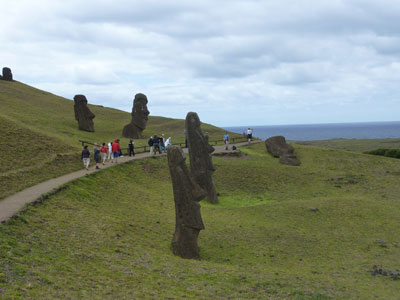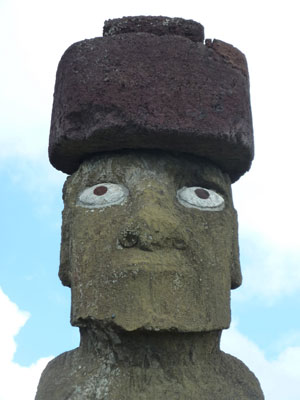A short visit to Easter Island
This item appears on page 14 of the March 2014 issue.
Easter Island, or Rapa Nui, is so remote that it is not “on the way” to anywhere else, which is why it took me over 30 years to finally get there. Prior to a tour of South America, I visited Oct. 24-28, 2012, reserving a hotel online and booking tours upon arrival.
Situated in the southeastern Pacific over 2,000 miles off the coast of Chile, it is a small, triangular-shaped island with a main town of over 3,000 residents and an airport with a very long runway built by NASA.
In 1985, when NASA decided to operate space shuttle missions out of Vandenberg Air Force Base near Lompoc, California, Easter Island was seen as an ideal choice for emergency landings. Chile’s president approved the project, and the runway was lengthened to 9,524 feet. Of all the world’s airports, it is the most remote from any other airport, situated 1,617 miles from the next-nearest one in French Polynesia.
Following the Challenger disaster in January 1986, California was not used for shuttle missions after all, which meant the island was not used for shuttle landings. The lengthening of the runway, however, opened the island to more visitors, which had a huge impact on the local economy.
Hollywood also had a big impact on the economy when the movie “Rapa Nui” was filmed on the island in 1993. It took six months to film and employed many locals as extras, making it possible for many islanders to purchase, for the first time, cars and electronic goods.
Hanga Roa, the main town, is small enough to walk through and enjoy at leisure. There are many small inns there as well as a few larger hotels.
The Kaimana Inn, where I stayed, was conveniently located but noisier than I expected. Children rode their trikes up and down the walkway outside my room, although no one else seemed bothered by the noise. Also, a restaurant about a block from the inn put on a cultural show twice in four nights that included very loud music until about 10 p.m.
Food on the island was very expensive, since most of it has to be imported from Chile. Many restaurants had set menus, which could be a good value, averaging around $20 for a 2- or 3-course meal, nothing fancy. (A similar meal in the United States would cost $10-$12.) A very simple sandwich cost about $8. Empanadas — a staple in much of South America and much less expensive — cost $3-$5 each.
There also were many shops and supermarkets where picnic supplies could be purchased.
Along the beach in the main part of Hanga Roa are several moai (carved stone figures), and tours to see the other moai around the island are easy to schedule.
A south coast tour to many of the ruins of ahu (platforms on which moai stand) lasts a full day. The highlight of the tour, and perhaps the island, is the quarry Rano Raraku, which contains 397 moai in various stages of carving.
The stone is hardened volcanic ash, so its softness makes it prone to breakage. The number of unbroken statues around the island is a testament to the ability of the people who moved them, perhaps with ropes and pulleys.
Once a moai reached its platform, the eye sockets were carved. White coral was used to make the eyes, with the pupils made from the same red stone as the topknots.
The quarry has well-marked paths and some benches on which to rest during the uphill walk. One could easily spend the better part of a day there, soaking up the beauty of the moai and the surroundings.
There is a nice mixture of restored and unrestored moai throughout the island, and even the moai that are toppled and badly weathered are interesting. Ahu Tongariki, the largest ahu, is a spectacular sight, with 15 restored moai standing sentinel. Ahu Akivi has seven moai that are facing the sea, as opposed to looking inland.
I’d advise visiting the small museum in town before going out to see the moai. It is well laid out, and visitors are provided with booklets in English or other languages.
Several extinct volcanoes exist on the island, and Rano Kau, the one closest to the town of Hanga Roa, is very interesting. The area is part of Rapa Nui National Park so is set up with paths and signs.
My five days on Rapa Nui passed too quickly. One could spend a week just hiking around the island or exploring by motorbike.
JUDITH ANSHIN
Contributing Editor


